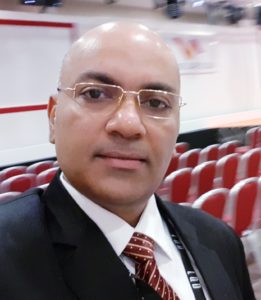Introduction by Steven Kravitz, DPM FAPWHc, FACFAS, Executive Director and Founder APWH
“Making More With Less in India,” a Perspective from Kshitij Shankhdhar, MD, Lucknow, India
I’m very pleased to have the opportunity to share with you this interesting and insightful article that challenges much of the teaching that we provide daily in Wound Healing Centers and noted by the closing line in this introduction.
Dr. Kshitij Shankhdhar is an allopathic physician practicing in Lucknow, India. He is a fellow of the APWH and the Medical Director and Diabetologist of Lucknow Diabetic Foot Care Clinic and Research Center. Lucknow is the capital of Uttar Pradesh which is located in the northwestern portion of India. The city is located in the center portion of the Pradesh with a population of more than 2.8 million. Considering the overall population of India, it has relatively limited resources compared to a city of similar size in the US.
The article by Dr. Shankhdhar points to the limited world wide availability of accessing the gold standard model, multidisciplinary wound care team approach, commonly described in the US and industrialized countries.
He has developed a national reputation in India and has become an international speaker representing third world medicine in the challenging field of wound care and limb preservation. The article describes a one man team approach, one provider dispensing all of the care needed to salvage and save a limb. As a closing commentary, it also brings to question how a multidisciplinary team approach can be the gold standard if the majority of the world’s population is not able to access it including much of the rural areas of the United States.
Making More with Less in India

Dr. Kshitij Shankhdhar, MD, FAPWH, Diabetologist
Lucknow, India
Multidisciplinary team approach (MTA) to diabetic foot care is considered the gold standard. It involves a number of professionals like the diabetologist, podiatrist, orthotist, surgeon, nurse, educator and the patient. The ideal scenario is that all the team members work in coordination and help the patient, achieve healing. The unfortunate reality is that such a team doesn’t exist in majority of hospitals, across the globe. Even where it exists, often it lacks the coordination and the presence of communication gap between the professionals, leads to poor clinical outcomes. The patient is often confused regarding whom to consider the team leader amongst the team of experts. There is a lack of emotional connection and bonding, which deteriorates the compliance of the patient. It’s an old saying, too many cooks, spoil the broth.
MTA proves to be expensive, cumbersome and impractical for the patient because often he has to consult the different experts, separately. In an analysis by Peter Cavanagh group, it was concluded that the cost to heal a complex diabetic foot ulcer is between 3 months and 6 years’ salary depending on nationality. The estimated annual US Burden of Diabetic Foot Ulcers is at least $15 Billion. MTA, especially in the developing world is neither available nor affordable by most diabetic patients. Diabetes is increasing faster in the world’s developing economies. The World Health Organization predicts that approximately 80% of all new cases of diabetes are expected to occur in developing countries. Up to 34% of those with diabetes will develop a foot ulcer.
The author presents his original concept – One Man Team Approach (OMTA) to diabetic foot amputation prevention. In OMTA, the Physician manages diabetes as well as takes care of various other aspects of diabetic foot care like wound care, offloading, dressings, footwear changes, education and minor debridement. One must remember that majority of the diabetic foot amputations begin with small ulcers, which a Physician (MBBS graduate – Bachelor of Medicine and Bachelor of Surgery) is competent enough to manage. Physicians should visit specialized clinics for further exposure and basic training in multiple disciplines related to diabetic foot care, rather than referring the patient to multiple consultants, except in serious diabetic foot conditions that needs invasive surgery or amputation. For instance, the author (Kshitij Shankhdhar) has specialized in Diabetology and nutrition. He has also gained experience in podiatry and has been performing most of the operative work himself. He even renders education to his patients using mobi-films (patient education films made using mobile phones).
In the world of gadgets, there is a camera, a phone, a calculator, a torch etc but when we bring all together in one device – a smart phone, it becomes such a practical solution and a global success. Similarly, OMTA shall be effective across the globe when Physicians do multitasking. If the Physicians examine every diabetic feet, detect and manage lesions early, it will significantly contribute to reducing the number of diabetic foot amputations, globally.
